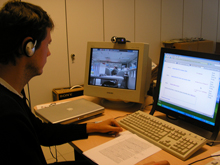Pisa takes the Owl Shift

Pierluigi Catastini covers a shift for CDF from Pisa. The control rooms
are connected by network and streaming video and separated by 4,700 miles. Click the image to see view at CDF.
Scientists from opposite sides of the world often work in the same control room on the same shift. Scientists who work the same shift from control rooms on opposite sides of the world, though, are a bit of a novelty.
If you happen to be around the CDF control room during the owl shift, 12:00 a.m. to 8:00 a.m., in the next few days you'll find they are one man down. Three people are at work instead of the usual four. A physicist in Pisa covers the position normally manned by this fourth person, data quality monitoring. For those in Pisa, the Batavia owl shift is a friendlier 7 a.m. to 3 p.m. daytime shift.
Pisa is able to monitor data through a network connection, browsing a CDF webpage. A live video connection between Pisa and CDF keeps the team, separated by 4,700 miles, coordinated. "Human communication is essential," said Kaori Maeshima, Fermilab physicist who works on remote detection operations for both CDF and CMS. "The person viewing results must be able to say, 'Hey guys, something's wrong--you'd better look at it.'"
CDF and their Pisa collaborators from the Istituto Nazionale di Fisica Nucleare benefit from this remote monitoring. "It's much nicer to work during the day than at night," said Fabrizio Scuri, senior physicist at INFN. CDF spokesperson Rob Roser added, "It allows us to fill a difficult shift by exploiting the time difference. That person is more alert than they would otherwise be."
Cost savings and avoiding travel are another practical boon. "It's expensive to take long trips to attend shifts," said Scuri. "We are suffering with budget cuts. If we can show we are making an effort to save money--that's good."
For Pisa the ability to participate in CDF, while staying in Italy, may attract other collaborators. "For the moment everyone is very glad," said Scuri.
The initial run of the remote shift, two weeks long, is scheduled to end next Saturday, November 25. If these remote shifts are successful, Pisa will take over the owl shift one week of each month, and other remote monitoring stations may be set up. DZero was the first Fermilab collider experiment to operate round-the-clock remote control room shifts, running detector monitoring from Brazil, India and Europe between 2003 and 2005.
While Fermilab's LHC remote operations center will work differently, the CDF and DZero remote shifts are important developmental steps. "It is a good working model," said Maeshima. "It is good implication that CMS will be successful."
--D.A. Venton |